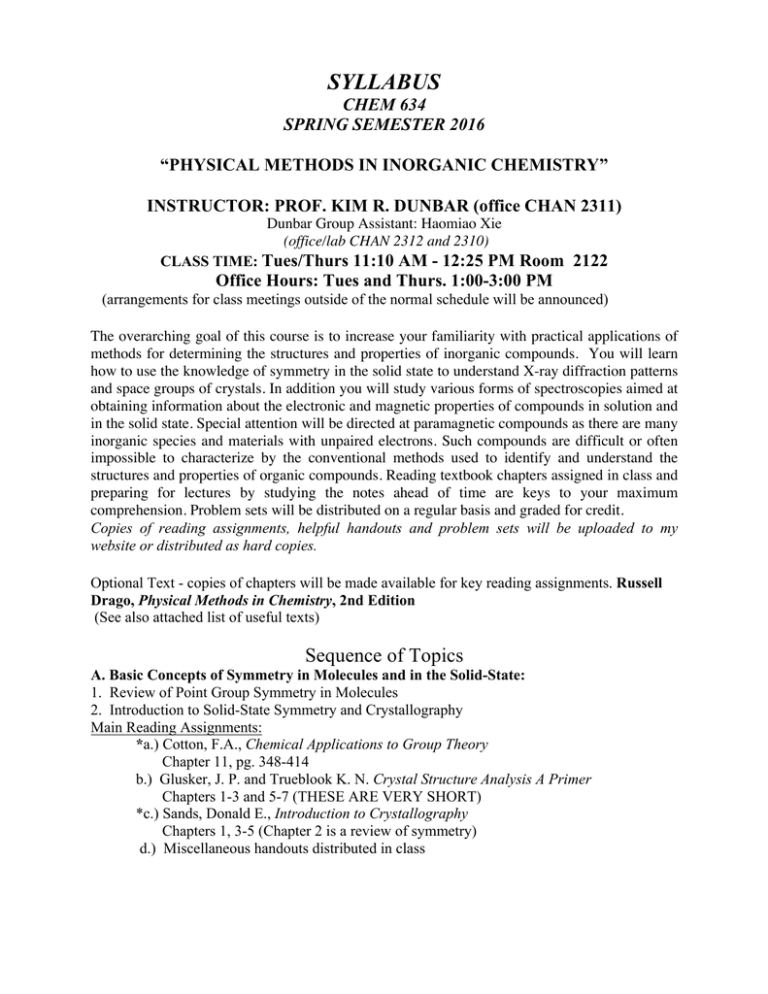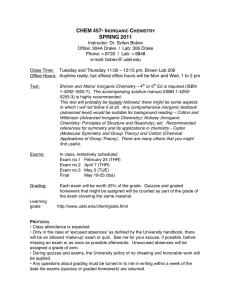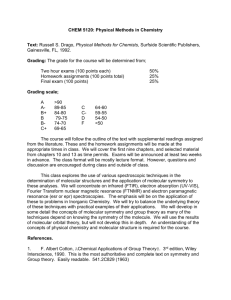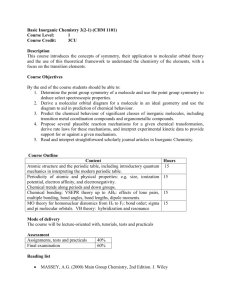SYLLABUS
advertisement

SYLLABUS CHEM 634 SPRING SEMESTER 2016 “PHYSICAL METHODS IN INORGANIC CHEMISTRY” INSTRUCTOR: PROF. KIM R. DUNBAR (office CHAN 2311) Dunbar Group Assistant: Haomiao Xie (office/lab CHAN 2312 and 2310) CLASS TIME: Tues/Thurs 11:10 AM - 12:25 PM Room 2122 Office Hours: Tues and Thurs. 1:00-3:00 PM (arrangements for class meetings outside of the normal schedule will be announced) The overarching goal of this course is to increase your familiarity with practical applications of methods for determining the structures and properties of inorganic compounds. You will learn how to use the knowledge of symmetry in the solid state to understand X-ray diffraction patterns and space groups of crystals. In addition you will study various forms of spectroscopies aimed at obtaining information about the electronic and magnetic properties of compounds in solution and in the solid state. Special attention will be directed at paramagnetic compounds as there are many inorganic species and materials with unpaired electrons. Such compounds are difficult or often impossible to characterize by the conventional methods used to identify and understand the structures and properties of organic compounds. Reading textbook chapters assigned in class and preparing for lectures by studying the notes ahead of time are keys to your maximum comprehension. Problem sets will be distributed on a regular basis and graded for credit. Copies of reading assignments, helpful handouts and problem sets will be uploaded to my website or distributed as hard copies. Optional Text - copies of chapters will be made available for key reading assignments. Russell Drago, Physical Methods in Chemistry, 2nd Edition (See also attached list of useful texts) Sequence of Topics A. Basic Concepts of Symmetry in Molecules and in the Solid-State: 1. Review of Point Group Symmetry in Molecules 2. Introduction to Solid-State Symmetry and Crystallography Main Reading Assignments: *a.) Cotton, F.A., Chemical Applications to Group Theory Chapter 11, pg. 348-414 b.) Glusker, J. P. and Trueblook K. N. Crystal Structure Analysis A Primer Chapters 1-3 and 5-7 (THESE ARE VERY SHORT) *c.) Sands, Donald E., Introduction to Crystallography Chapters 1, 3-5 (Chapter 2 is a review of symmetry) d.) Miscellaneous handouts distributed in class B. Methodologies and Applications of Inorganic Electronic Structure and Spectroscopy: 1. Electronic Spectroscopy Overview of Bonding Theories and Models Free Ions versus Ligand Field/Crystal Field Stabilized Ions Electron Configurations Represented as States for Spectral Predictions Spectrochemical Series Jahn-Teller Effect Tanabe-Sugano Diagrams Main Reading Assignments: a.) Drago (text) Chapter 5, pg. 109-148 (basics) Chapter 10, pg. 409-468 (metal complexes) b.) Cotton, F.A., Chemical Applications to Group Theory Chapter 9, pg. 253-303 (supplementary) C. Methodologies of Structural Determination and Structure/Property Relationships for Paramagnetic Systems 2. EPR Spectroscopy Fundamentals Organic Molecules Versus Transition Metal Complexes Spectral Predictions Main Reading Assignments: Drago (text) Chapter 9, pg. 360-408 (basics) Chapter 13, pg. 559-603 (metal complexes) 3. Fundamentals and Applications of Magnetochemistry Diamagnetism, Paramagnetism in Isolated Molecules Antiferromagnetic and Ferromagnetic Coupling in Ensembles of Spins Antiferromagnetic, Ferromagnetic & Other Types of Bulk Ordering Models and Theories in Brief Main Reading Assignments: a.) Drago (text) Chapter 11, pg. 469-499 b.) Carlin, Richard L., Magnetochemistry Chapters 1-4 Literature and Miscellaneous Handouts D. Methodologies and Applications of NMR Spectroscopy to Inorganic Systems 4. NMR Spectroscopy Fundamental issues (chemical shift, 1T, assignments) Multinuclear approaches 1H, 31P, 19F etc. Dynamic NMR Paramagnetic NMR Main Reading Assignments: Literature and Miscellaneous Handouts E. Cyclic Voltammetry Basics of the Technique and Applications to Inorganic Chemistry Main Reading Assignments Literature and Miscellaneous Handouts Grading Scheme Homework 30% (due by 5 PM) Exam I Exam II Final (not comprehensive) 25% 25% 20% Sources of Additional Reading Material and Reference Materials TEXAS A&M UNIVERSITY BOOKS FOR CHEM 634 “PHYSICAL METHODS IN INORGANIC CHEMISTRY” SPRING 2004 Primary Reading Material Author(s) Title Drago, Russel *Sands, Donald E. Physical Methods for Chemists 2nd Edition (classic text, out of print) *Chemical Applications of Group Theory, (classic) 3rd Edition *Introduction to Crystallography (beginners) *Carlin, Richard L. *Magnetochemistry (classic, good intro chapters) * John P. Fackler, Larry R. Falvello, editors, 2011 * Techniques in Inorganic Chemistry (great chapters on structure determination by modern methods) *Cotton, F.A. Supplementary Reading Material Ballhausen, Carl J. Introduction to Ligand Field Theory (classic) Carter, Robert L. “Molecular Symmetry and Group Theory” (undergraduate level) Advanced Inorganic Chemistry (classic) 5th Edition Coordination Chemistry Symmetry and Spectroscopy: An Introduction to Vibrational and Electronic Spectroscopy (classic) Inorganic Chemistry (undergraduate level) 4th Edition Molecular Magnetism (a basic knowledge is required) Cotton, F.A. & Wilkinson Joan Ribas Gispert Harris, Daniel & Bertolucci, M.D. Huheey, James E. Kahn, Oliver Nakamoto Editors: Solomon, E.I. Lever, A.B.P. Infrared and Raman Spectra of Inorganic and Coordination Compounds (Practical Reference Book) Inorganic Electronic Structure and Spectroscopy Volumes I and II *Books will also contain some assigned reading material. There are many other books than the aforementioned that address the same topics; if you have one that works for you, by all means use it. The main point is that you understand the concepts. It doesn’t matter how you go about doing it. ADA Policy Statement The Americans with Disabilities Act (ADA) is a federal anti-discrimination statute that provides comprehensive civil rights protection for persons with disabilities. Among other things, this legislation requires that all students with disabilities be guaranteed a learning environment that provides for reasonable accommodation of their disabilities. If you believe you have a disability requiring an accommodation, please contact Disability Services, in Cain Hall, Room B118, or call 845-1637. For additional information visit http://disability.tamu.edu Copyrights Statement Please note that all handouts and supplements used in this course are copyrighted. This includes all materials generated for this class, including but not limited to syllabi, exams, in-class materials, review sheets, and lecture outlines. Materials may be downloaded or photocopied for personal use only, and may not be given or sold to other individuals. Aggie Code of Honor For many years Aggies have followed a Code of Honor, which is stated in this very simple verse: An Aggie does not lie, cheat or steal or tolerate those who do. The Aggie Code of Honor is an effort to unify the aims of all Texas A&M men and women toward a high code of ethics and personal dignity. For most, living under this code will be no problem, as it asks nothing of a person that is beyond reason. It only calls for honesty and integrity, characteristics that Aggies have always exemplified. The Aggie Code of Honor functions as a symbol to all Aggies, promoting understanding and loyalty to truth and confidence in each other. Upon accepting admission to Texas A&M University, a student immediately assumes a commitment to uphold the Honor Code, to accept responsibility for learning and to follow the philosophy and rules of the Honor System. Students will be required to state their commitment on examinations, research papers, and other academic work. Ignorance of the rules does not exclude any member of the Texas A&M University community from the requirements or the processes of the Honor System. For additional information, please visit: www.tamu.edu/aggiehonor



